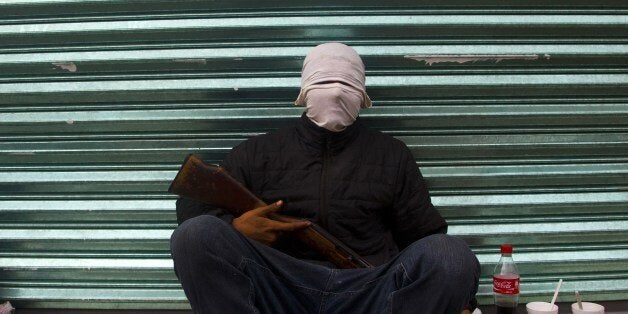
In response to years of abuse, kidnappings for ransom, rapes, killings and extortions from criminal organizations, farmers, businessmen, doctors, lawyers, hotel owners, truck drivers and common citizens from the lowlands of Michoacán in Mexico are taking up arms.
In less than a year, the so-called self-defense groups achieved what the federal government with its police force and army could not do in 12 years: oust from the state the criminals who made their life miserable. Remarkably, this story does not have a very happy ending or beginning.
The ordeal in Michoacán started when the internal fights of the drug cartels active in the area produced a splinter group called the Order of the Templars. They rose to control nearly all legal and illegal economic activities in the state. They took over the main port of the state to smuggle precursor chemicals from China and cocaine from Colombia and Peru with the intent to sell them in the United States -- and CDs, DVDs and designer clothes made by pirate organizations for domestic consumption.
The corrupting power of the Templars extended to the world of politics controlling most mayors, placing their people in key positions and supporting the political campaigns of candidates from all parties. The Templars were the indisputable authority in the state, an authority that enabled them to abuse anyone they wished.
To kick the Templars out, the self-defense group sought and got the help of another criminal organization. The assistance was prompt and so brutal it began by throwing the severed heads of six members of the Templars in the dance hall of a local bar, under the complacent gaze of corrupt local authorities.
That all this mess took place in the Mexican state where former President Felipe Calderón was born, and where he started the drug war that was to be the landmark of his administration, exposes not only his biggest blunder but also sets a dangerous precedent in a country where respect for the rule of law is not deeply ingrained in the culture.
It also raises several questions. To help us understand why the self-defense groups succeeded where the Calderon administration failed, I asked Salvadoran former guerrilla commander and one of Calderon's security advisors Joaquín Villalobos to offer an explanation.
"The self-defense groups are territorial natural forces linked to the local population," he says. "In the same way that drug dealers or guerrillas are connected to the local population, they live in the same territory. The police and armies that the government uses to combat criminals are specialized and professional forces without local roots. They are like parachutists that touch and go. With qualified police and the military you can destroy cartels, but without territorial forces, it is impossible to reduce violence."
LIKE LOCAL GUERILLASSelf-defense groups are reportedly being formed in at least eight states of the Mexican republic, but Raymundo Riva Palacio, a veteran Mexican journalist, believes that is a slight exaggeration.
"There are self-defense groups in Guerrero, but in the rest of the republic they are totally under the control of the government," he says. "What is true is that in Acapulco, widows and mothers of victims of criminal violence are organizing their groups and the same is true among the indigenous peoples of the state of Guerrero."
Public opinion polls show that the majority of Mexicans believe self-defense is the best way to protect your community, and a larger majority sees nothing wrong with vigilante justice. One could argue that such an outcome is predictable in a country where 105,000 people are kidnapped for ransom every year, where criminal groups blackmail one of every 10 Mexicans and 96 percent of recorded crimes go unpunished.
Notwithstanding the public support and the dismal justice record, do people have the right to bear arms to protect themselves in a country that forbids the sale and use of arms? Is the Mexican government so weak it needs citizens militia to protect its citizens? Will these armed movements help build institutions in Mexico? Is vigilante justice the way of the future?
"Vigilantism is a genie that no one really wants to let out of the bottle. Once it starts, how do you control it?" says Charles Shapiro, former U.S. ambassador to Venezuela and current president of the Institute of the Americas in San Diego, California. "Vigilantism in the name of the law is in many ways antithetical to the rule of law. Unlike the state, which also manages to abuse power regularly, self-defense group don't recognize the role of courts, prosecutors, or laws. On the other hand, if the state can't maintain law and order does it forgo its right to hold the monopoly of power in a territory?"
THE COLOMBIANIZATION OF MEXICOThe temptation to compare Mexico's current problems with Colombia's in the 1980s and 90s is irresistible. In Colombia, there was a time when paramilitary armies were used to protect mostly wealthy people, from FARC and ELN guerrillas and drug cartels. Former Colombian President César Gaviria says it is hard to compare the two phenomena, however, he says "there is one basic similarity, in both countries the people end-up trying to administer justice. The problem, though, is that so-called self-defense groups only generate more violence. In Colombia, the purported solution became a bigger problem. With the paramilitary, the drug cartels multiplied, and it was only with the assistance of Plan Colombia that the Colombian government was able to combat all of them."
Can these self-defense groups help to build institutions in Mexico? Peter Hakim, president emeritus and senior fellow of the Inter-American Dialogue says it's not likely.
"But I am sure you can identify countries in which they have," he says. "In Peru they helped defeat Sendero Luminoso. However, history shows vigilantism it is far too dangerous. Clearly, the Mexican government does not do a great job protecting its citizens or asserting the rule of law very effectively but Brazil is not doing much better. Rural riots are a constant in China, and the U.S. essentially refused to enforce the laws in the South for many years."
Once the self-defense groups of Michoacan expelled the Templars, the government of Enrique Peña Nieto decided to incorporate them into some sort of "rural police"-- a questionable decision that sets a bad precedent and could have dire consequences.
"That was a serious mistake because it contaminates the police force," says Gaviria, alluding to its links with drug cartels. Riva Palacio, the Mexican journalist concurs: "it is a judicial aberration to pretend to bring about the rule of law using illegal paramilitary forces and it will not help the country advance in the right direction."
Before rushing to blame Mexico for its real problems, one must understand the context of the present day story. Michoacán is in such trouble because of the insatiable appetite for drugs in the United States and because people there kill each other with weapons purchased in the U.S. and smuggled into Mexico.
Mexico has a terrible problem that often seems uncontrollable and is tearing it apart, but the United States must take responsibility for the havoc its voracious drug addiction and obscene weapons trade has wrought on its neighbor.
